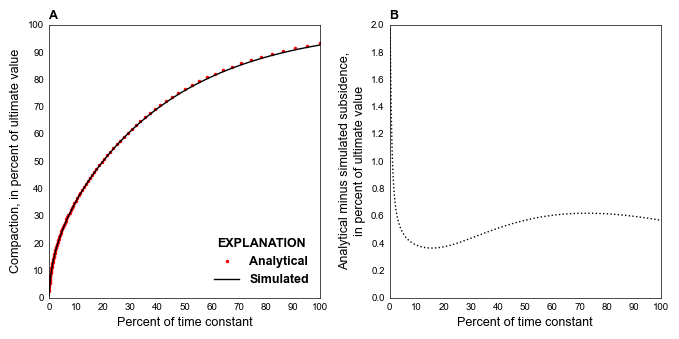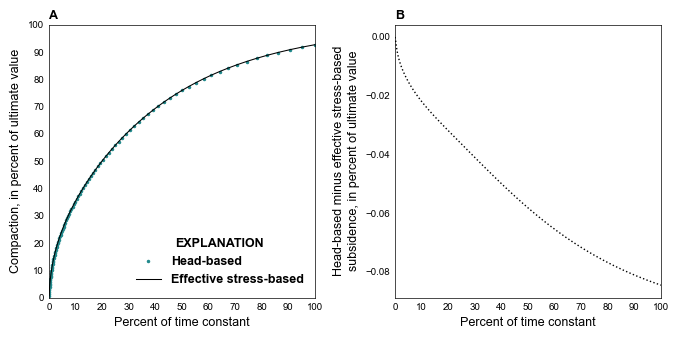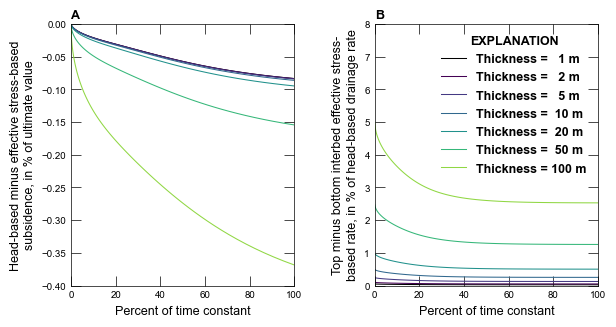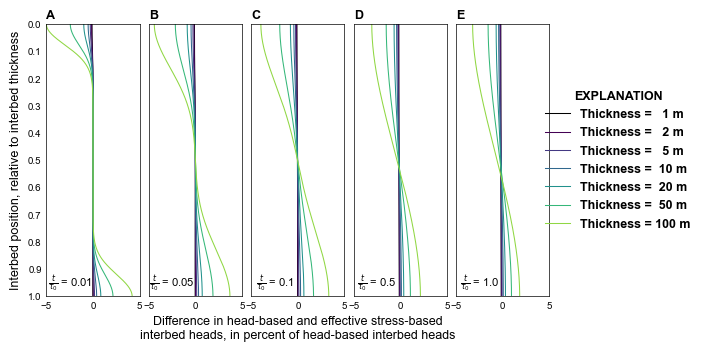This page was generated from
ex-gwf-csub-p02.py.
It's also available as a notebook.
Delay interbed drainage example
This problem simulates the drainage of a thick interbed caused by a step decrease in hydraulic head in the aquifer and is based on MODFLOW-2000 subsidence package sample problem 1.
Initial setup
Import dependencies, define the example name and workspace, and read settings from environment variables.
[1]:
import os
import pathlib as pl
import flopy
import git
import matplotlib as mpl
import matplotlib.pyplot as plt
import numpy as np
from flopy.plot.styles import styles
from modflow_devtools.misc import get_env, timed
# Example name and workspace paths. If this example is running
# in the git repository, use the folder structure described in
# the README. Otherwise just use the current working directory.
sim_name = "ex-gwf-csub-p02"
try:
root = pl.Path(git.Repo(".", search_parent_directories=True).working_dir)
except:
root = None
workspace = root / "examples" if root else pl.Path.cwd()
figs_path = root / "figures" if root else pl.Path.cwd()
tbls_path = root / "tables" if root else pl.Path.cwd()
# Settings from environment variables
write = get_env("WRITE", True)
run = get_env("RUN", True)
plot = get_env("PLOT", True)
plot_show = get_env("PLOT_SHOW", True)
plot_save = get_env("PLOT_SAVE", True)
# ### Define parameters
#
# Define model units, parameters and other settings.
[2]:
# Scenario-specific parameters
parameters = {
"ex-gwf-csub-p02a": {
"head_based": True,
"bed_thickness": (1.0,),
"kv": (2.5e-06,),
"ndelaycells": 19,
},
"ex-gwf-csub-p02b": {
"head_based": False,
"bed_thickness": (1.0,),
"kv": (2.5e-06,),
"ndelaycells": 19,
},
"ex-gwf-csub-p02c": {
"head_based": True,
"bed_thickness": (1.0, 2.0, 5.0, 10.0, 20.0, 50.0, 100.0),
"kv": (2.5e-06, 1e-05, 6.25e-05, 0.00025, 0.001, 0.00625, 0.025),
"ndelaycells": 1001,
},
}
# Model units
length_units = "meters"
time_units = "days"
# Model parameters
nper = 1 # Number of periods
nlay = 1 # Number of layers
ncol = 3 # Number of columns
nrow = 1 # Number of rows
delr = 1.0 # Column width ($m$)
delc = 1.0 # Row width ($m$)
top = 0.0 # Top of the model ($ft$)
botm = -1000.0 # Layer bottom elevations ($m$)
strt = 0.0 # Starting head ($m$)
icelltype = 0 # Cell conversion type
k11 = 1.0e6 # Horizontal hydraulic conductivity ($m/d$)
sgm = 1.7 # Specific gravity of moist soils (unitless)
sgs = 2.0 # Specific gravity of saturated soils (unitless)
tau0 = 1000.0 # Interbed drainage time constant (unitless)
cg_theta = 0.2 # Coarse-grained material porosity (unitless)
ske = 1.0e-5 # Elastic specific storage ($1/m$)
skv = 1.0e-2 # Inelastic specific storage ($1/m$)
theta = 0.45 # Interbed porosity (unitless)
h0 = 1.0 # Initial interbed head ($m$)
head_offset = 1.0 # Initial preconsolidation head ($m$)
# Time discretization
tdis_ds = ((1000.0, 100, 1.05),)
# Constant head cells
c6 = []
for j in range(0, ncol, 2):
c6.append([0, 0, j, strt])
# Solver parameters
nouter = 1000
ninner = 300
hclose = 1e-9
rclose = 1e-6
linaccel = "bicgstab"
relax = 0.97
Model setup
Define functions to build models, write input files, and run the simulation.
[3]:
def build_models(
name,
subdir_name=".",
head_based=True,
bed_thickness=1.0,
kv=2e-6,
ndelaycells=19,
):
sim_ws = os.path.join(workspace, name)
if subdir_name is not None:
sim_ws = os.path.join(sim_ws, subdir_name)
sim = flopy.mf6.MFSimulation(sim_name=name, sim_ws=sim_ws, exe_name="mf6")
flopy.mf6.ModflowTdis(sim, nper=nper, perioddata=tdis_ds, time_units=time_units)
flopy.mf6.ModflowIms(
sim,
outer_maximum=nouter,
outer_dvclose=hclose,
linear_acceleration=linaccel,
inner_maximum=ninner,
inner_dvclose=hclose,
relaxation_factor=relax,
rcloserecord=f"{rclose} strict",
)
gwf = flopy.mf6.ModflowGwf(
sim, modelname=name, save_flows=True, newtonoptions="newton"
)
flopy.mf6.ModflowGwfdis(
gwf,
length_units=length_units,
nlay=nlay,
nrow=nrow,
ncol=ncol,
delr=delr,
delc=delc,
top=top,
botm=botm,
)
# gwf obs
flopy.mf6.ModflowUtlobs(
gwf,
digits=10,
print_input=True,
continuous={"gwf_obs.csv": [("h1_1_2", "HEAD", (0, 0, 1))]},
)
flopy.mf6.ModflowGwfic(gwf, strt=strt)
flopy.mf6.ModflowGwfnpf(
gwf,
icelltype=icelltype,
k=k11,
save_specific_discharge=True,
)
flopy.mf6.ModflowGwfsto(gwf, iconvert=icelltype, ss=0.0, sy=0, transient={0: True})
if head_based:
hb_bool = True
pc0 = head_offset
tsgm = None
tsgs = None
else:
hb_bool = None
pc0 = -head_offset
tsgm = sgm
tsgs = sgs
sub6 = [
[
0,
0,
0,
1,
"delay",
pc0,
bed_thickness,
1.0,
skv,
ske,
theta,
kv,
h0,
"ib1",
]
]
csub = flopy.mf6.ModflowGwfcsub(
gwf,
print_input=True,
save_flows=True,
head_based=hb_bool,
ndelaycells=ndelaycells,
boundnames=True,
ninterbeds=1,
sgm=tsgm,
sgs=tsgs,
cg_theta=cg_theta,
cg_ske_cr=0.0,
beta=0.0,
packagedata=sub6,
)
opth = f"{name}.csub.obs"
csub_csv = opth + ".csv"
obs = [
("tcomp", "interbed-compaction", "ib1"),
("sk", "sk", "ib1"),
("qtop", "delay-flowtop", (0,)),
("qbot", "delay-flowbot", (0,)),
]
for k in range(ndelaycells):
tag = f"H{k + 1:04d}"
obs.append((tag, "delay-head", (0,), (k,)))
if not head_based:
iposm = int(ndelaycells / 2) + 1
iposb = ndelaycells - 1
obs += [
("est", "delay-estress", (0,), (0,)),
("esm", "delay-estress", (0,), (iposm,)),
("esb", "delay-estress", (0,), (iposb,)),
("gs", "gstress-cell", (0, 0, 1)),
("es", "estress-cell", (0, 0, 1)),
]
orecarray = {csub_csv: obs}
csub.obs.initialize(
filename=opth, digits=10, print_input=True, continuous=orecarray
)
flopy.mf6.ModflowGwfchd(gwf, stress_period_data={0: c6})
flopy.mf6.ModflowGwfoc(
gwf,
printrecord=[("BUDGET", "ALL")],
)
return sim
def write_models(sim, silent=True):
sim.write_simulation(silent=silent)
@timed
def run_models(sim, silent=True):
success, buff = sim.run_simulation(silent=silent)
assert success, buff
Plotting results
Define functions to plot model results, beginning with an analytical solution to superimpose over the simulated solution.
[4]:
def analytical_solution(z, t, dh=1.0, b0=1.0, ssk=100.0, vk=0.025, n=100, silent=True):
v = 0.0
e = np.exp(1)
pi = np.pi
pi2 = np.pi**2
# calculate infinite sum
for k in range(n):
fk = float(k)
tauk = (0.5 * b0) ** 2.0 * ssk / ((2.0 * fk + 1.0) ** 2.0 * vk)
ep = ((2.0 * fk + 1.0) ** 2 * pi2 * vk * t) / (4.0 * ssk * (0.5 * b0) ** 2.0)
rad = (2.0 * fk + 1.0) * pi * z / b0
v += ((-1.0) ** fk / (2.0 * fk + 1.0)) * (e**-ep) * np.cos(rad)
if not silent:
print(f"{k:5d} {tauk:20g} {rad:20g} {v:20g}")
return dh - 4.0 * dh * v / pi
# Set figure properties specific to the problem
figure_size = (6.8, 3.4)
arrow_props = dict(facecolor="black", arrowstyle="-", lw=0.5)
def plot_grid(sim, silent=True):
with styles.USGSMap() as fs:
name = sim.name
gwf = sim.get_model(name)
fig, ax = plt.subplots(figsize=(6.8, 2.0))
mc = flopy.plot.PlotCrossSection(model=gwf, line={"Row": 0}, ax=ax)
ax.fill_between([0, 1], y1=0, y2=botm, color="cyan", alpha=0.5)
styles.add_text(
ax=ax,
text="Constant head",
x=0.5,
y=-500.0,
bold=False,
italic=False,
transform=False,
va="center",
ha="center",
fontsize=9,
)
ax.fill_between([2, 3], y1=0, y2=botm, color="cyan", alpha=0.5)
styles.add_text(
ax=ax,
text="Constant head",
x=2.5,
y=-500.0,
bold=False,
italic=False,
transform=False,
va="center",
ha="center",
fontsize=9,
)
ax.fill_between([1, 2], y1=-499.5, y2=-500.5, color="brown", alpha=0.5)
styles.add_annotation(
ax=ax,
text="Delay interbed",
xy=(1.5, -510.0),
xytext=(1.6, -300),
bold=False,
italic=False,
fontsize=9,
ha="center",
va="center",
zorder=100,
arrowprops=arrow_props,
)
mc.plot_grid(color="0.5", lw=0.5, zorder=100)
ax.set_xlim(0, 3)
ax.set_ylabel("Elevation, in meters")
ax.set_xlabel("x-coordinate, in meters")
styles.remove_edge_ticks(ax)
plt.tight_layout()
if plot_show:
plt.show()
if plot_save:
fpth = figs_path / f"{sim_name}-grid.png"
if not silent:
print(f"saving...'{fpth}'")
fig.savefig(fpth)
def plot_head_based(sim, silent=True):
with styles.USGSPlot() as fs:
name = sim.name
# get csub observations
ws = sim.simulation_data.mfpath.get_sim_path()
s = flopy.mf6.MFSimulation().load(sim_ws=ws, verbosity_level=0)
gwf = s.get_model(name)
cobs = gwf.csub.output.obs().data
# calculate the compaction analytically
ac = []
nz = 100
thick = parameters[name]["bed_thickness"][0]
kv = parameters[name]["kv"][0]
dhalf = thick * 0.5
az = np.linspace(-dhalf, dhalf, num=nz)
dz = az[1] - az[0]
for tt in cobs["totim"]:
c = 0.0
for jdx, zz in enumerate(az):
f = 1.0
if jdx == 0 or jdx == nz - 1:
f = 0.5
h = analytical_solution(zz, tt, ssk=skv, vk=kv, n=200, dh=1.0)
c += h * skv * f * dz
ac.append(c)
ac = np.array(ac)
# calculate normalized simulation time
tpct = cobs["totim"] * 100 / tau0
# plot the results
fig = plt.figure(figsize=figure_size)
gs = mpl.gridspec.GridSpec(1, 2, figure=fig)
idx = 0
ax = fig.add_subplot(gs[idx])
ax.plot(
tpct,
100 * ac / skv,
marker=".",
lw=0,
ms=3,
color="red",
label="Analytical",
)
ax.plot(
tpct,
100 * cobs["TCOMP"] / skv,
label="Simulated",
color="black",
lw=1,
zorder=100,
)
leg = styles.graph_legend(ax, loc="lower right")
ax.set_xticks(np.arange(0, 110, 10))
ax.set_yticks(np.arange(0, 110, 10))
ax.set_xlabel("Percent of time constant")
ax.set_ylabel("Compaction, in percent of ultimate value")
ax.set_xlim(0, 100)
ax.set_ylim(0, 100)
styles.heading(ax, letter="A")
styles.remove_edge_ticks(ax)
idx += 1
ax = fig.add_subplot(gs[idx])
ax.plot(tpct, 100 * (ac - cobs["TCOMP"]) / skv, lw=1, ls=":", color="black")
ax.set_xticks(np.arange(0, 110, 10))
ax.set_yticks(np.arange(0, 2.2, 0.2))
ax.set_xlabel("Percent of time constant")
ax.set_ylabel(
"Analytical minus simulated subsidence,\nin percent of ultimate value"
)
ax.set_xlim(0, 100)
ax.set_ylim(0, 2)
styles.heading(ax, letter="B")
styles.remove_edge_ticks(ax)
plt.tight_layout()
if plot_show:
plt.show()
if plot_save:
fpth = figs_path / f"{name}-01.png"
if not silent:
print(f"saving...'{fpth}'")
fig.savefig(fpth)
def plot_effstress(sim, silent=True):
verbose = not silent
with styles.USGSPlot() as fs:
name = sim.name
# get effective stress csub observations
gwf = sim.get_model(name)
cobs = gwf.csub.output.obs().data
# get head-based csub observations
name0 = name.replace("-p02b", "-p02a")
ws0 = os.path.join(workspace, name0)
sim0 = flopy.mf6.MFSimulation().load(sim_ws=ws0, verbosity_level=0)
gwf0 = sim0.get_model(name0)
cobs0 = gwf0.csub.output.obs().data
# calculate normalized simulation time
tpct = cobs["totim"] * 100 / tau0
# plot the results
fig = plt.figure(figsize=figure_size)
gs = mpl.gridspec.GridSpec(1, 2, figure=fig)
idx = 0
ax = fig.add_subplot(gs[idx])
ax.plot(
tpct,
100 * cobs0["TCOMP"] / skv,
lw=0,
marker=".",
ms=3,
color="#238A8DFF",
label="Head-based",
)
ax.plot(
tpct,
100 * cobs["TCOMP"] / skv,
lw=0.75,
label="Effective stress-based",
color="black",
zorder=100,
)
leg = styles.graph_legend(ax, loc="lower right")
ax.set_xticks(np.arange(0, 110, 10))
ax.set_yticks(np.arange(0, 110, 10))
ax.set_xlabel("Percent of time constant")
ax.set_ylabel("Compaction, in percent of ultimate value")
ax.set_xlim(0, 100)
ax.set_ylim(0, 100)
styles.heading(ax, letter="A")
styles.remove_edge_ticks(ax)
idx += 1
ax = fig.add_subplot(gs[idx])
ax.plot(
tpct,
100 * (cobs0["TCOMP"] - cobs["TCOMP"]) / skv,
lw=1,
ls=":",
color="black",
)
ax.set_xticks(np.arange(0, 110, 10))
ax.set_xlabel("Percent of time constant")
ax.set_ylabel(
"Head-based minus effective stress-based\nsubsidence, in percent of ultimate value"
)
ax.set_xlim(0, 100)
styles.heading(ax, letter="B")
styles.remove_edge_ticks(ax)
plt.tight_layout()
if plot_show:
plt.show()
if plot_save:
fpth = figs_path / f"{name}-01.png"
if not silent:
print(f"saving...'{fpth}'")
fig.savefig(fpth)
def get_subdirs(sim):
"""Get subdirectory names"""
name = sim.name
# get the subdirectory names
pth = os.path.join(workspace, name)
hb_dirs = [
name
for name in sorted(os.listdir(pth))
if os.path.isdir(os.path.join(pth, name)) and name.startswith("hb-")
]
es_dirs = [
name
for name in sorted(os.listdir(pth))
if os.path.isdir(os.path.join(pth, name)) and name.startswith("es-")
]
return hb_dirs, es_dirs
def fill_heads(rec_arr, ndcells):
"""Process interbed heads"""
arr = np.zeros((rec_arr.shape[0], ndcells), dtype=float)
for i in range(100):
for j in range(ndcells):
name = f"H{j + 1:04d}"
arr[i, j] = rec_arr[name][i]
return arr
def plot_comp_q_comparison(sim, silent=True):
"""Plot the results for multiple interbed thicknesses"""
with styles.USGSPlot():
name = sim.name
thicknesses = parameters[name]["bed_thickness"]
# get the subdirectory names
hb_dirs, es_dirs = get_subdirs(sim)
# setup the figure
fig = plt.figure(figsize=figure_size)
gs = mpl.gridspec.GridSpec(1, 2, figure=fig)
# set color
cmap = plt.get_cmap("viridis")
cNorm = mpl.colors.Normalize(vmin=0, vmax=6)
scalarMap = mpl.cm.ScalarMappable(norm=cNorm, cmap=cmap)
axes = []
for idx in range(2):
ax = fig.add_subplot(gs[idx])
if idx == 0:
ax.set_yticks(np.arange(-0.40, 0.1, 0.05))
ax.set_ylim(-0.40, 0)
ax.set_xlim(0, 100)
ylabel = (
"Head-based minus effective stress-based\nsubsidence, "
+ "in % of ultimate value"
)
else:
ax.set_ylim(0, 8)
ax.set_xlim(0, 100)
ylabel = (
"Top minus bottom interbed effective stress-\nbased "
+ "rate, in % of head-based drainage rate"
)
ax.set_xlabel("Percent of time constant")
ax.set_ylabel(ylabel)
styles.heading(ax, letter=chr(ord("A") + idx))
axes.append(ax)
plt.subplots_adjust(wspace=0.36)
for idx, (hb_dir, es_dir) in enumerate(zip(hb_dirs, es_dirs)):
sim_ws = os.path.join(workspace, name, hb_dir)
s = flopy.mf6.MFSimulation().load(sim_ws=sim_ws, verbosity_level=0)
g = s.get_model(name)
hb_obs = g.csub.output.obs().data
ws0 = os.path.join(workspace, name, es_dir)
s0 = flopy.mf6.MFSimulation().load(sim_ws=ws0, verbosity_level=0)
g0 = s0.get_model(name)
es_obs = g0.csub.output.obs().data
# calculate normalized simulation time
tpct = hb_obs["totim"] * 100 / tau0
thickness = thicknesses[idx]
if idx == 0:
color = "black"
else:
color = scalarMap.to_rgba(idx - 1)
label = f"Thickness = {int(thickness):>3d} m"
v = 100.0 * (hb_obs["TCOMP"] - es_obs["TCOMP"]) / (skv * thickness)
ax = axes[0]
ax.plot(tpct, v, color=color, lw=0.75, label=label)
denom = hb_obs["QTOP"] + hb_obs["QBOT"]
v = 100 * (es_obs["QTOP"] - es_obs["QBOT"]) / denom
ax = axes[1]
ax.plot(tpct, v, color=color, lw=0.75, label=label)
# legend
ax = axes[-1]
leg = styles.graph_legend(ax, loc="upper right")
if plot_show:
plt.show()
if plot_save:
fpth = figs_path / f"{name}-01.png"
if not silent:
print(f"saving...'{fpth}'")
fig.savefig(fpth)
def plot_head_comparison(sim, silent=True):
"""Plot the interbed head results for multiple interbed thicknesses"""
with styles.USGSPlot():
name = sim.name
ndcells = parameters[name]["ndelaycells"]
thicknesses = parameters[name]["bed_thickness"]
# get the subdirectory names
hb_dirs, es_dirs = get_subdirs(sim)
# setup the figure
fig = plt.figure(figsize=figure_size)
fig.subplots_adjust(left=0.06, right=0.95, top=0.95, bottom=0.15, wspace=0.1)
gs = mpl.gridspec.GridSpec(1, 6, figure=fig)
z = np.linspace(0, 1, ndcells)
yticks = np.arange(0, 1.1, 0.1)
# set color
cmap = plt.get_cmap("viridis")
cNorm = mpl.colors.Normalize(vmin=0, vmax=6)
scalarMap = mpl.cm.ScalarMappable(norm=cNorm, cmap=cmap)
# percentages to evaluate
pct_vals = (
1,
5,
10,
50,
100,
)
axes = []
for idx in range(6):
ax = fig.add_subplot(gs[idx])
ax.set_ylim(1, 0)
ax.set_xlim(-5, 5)
if idx < 5:
styles.heading(ax, letter=chr(ord("A") + idx))
ax.set_yticks(yticks)
styles.remove_edge_ticks(ax)
text = r"$\frac{t}{\tau_0}$ = " + "{}".format(pct_vals[idx] / 100.0)
ax.text(
0.25,
0.01,
text,
ha="center",
va="bottom",
transform=ax.transAxes,
fontsize=8,
)
else:
ax.set_xticks([])
ax.set_yticks([])
if idx == 0:
ax.set_ylabel("Interbed position, relative to interbed thickness")
else:
if idx == 2:
text = (
"Difference in head-based and effective stress-based"
+ "\ninterbed heads, in percent of head-based interbed heads"
)
ax.set_xlabel(text)
ax.set_yticklabels([])
axes.append(ax)
for idx, (hb_dir, es_dir) in enumerate(zip(hb_dirs, es_dirs)):
sim_ws = os.path.join(workspace, name, hb_dir)
s = flopy.mf6.MFSimulation().load(sim_ws=sim_ws, verbosity_level=0)
g = s.get_model(name)
hb_obs = g.csub.output.obs().data
hb_arr = fill_heads(hb_obs, ndcells)
ws0 = os.path.join(workspace, name, es_dir)
s0 = flopy.mf6.MFSimulation().load(sim_ws=ws0, verbosity_level=0)
g0 = s0.get_model(name)
es_obs = g0.csub.output.obs().data
es_arr = fill_heads(es_obs, ndcells)
#
# pth = os.path.join(ws, name, hb_dir, "{}.csub.obs.csv".format(name))
# hb_obs = np.genfromtxt(pth, names=True, delimiter=",")
# hb_arr = fill_heads(hb_obs, ndcells)
#
# pth = os.path.join(ws, name, es_dir, "{}.csub.obs.csv".format(name))
# es_obs = np.genfromtxt(pth, names=True, delimiter=",")
# es_arr = fill_heads(es_obs, ndcells)
# calculate normalized simulation time
tpct = hb_obs["totim"] * 100 / tau0
# calculate location closest to 1, 5, 10, 50, and 100 percent of time constant
locs = {}
for i in pct_vals:
for jdx, t in enumerate(tpct):
if t <= i:
locs[i] = jdx
for jdx, (key, ivalue) in enumerate(locs.items()):
# add data to the subplot
ax = axes[jdx]
if idx == 0:
color = "black"
else:
color = scalarMap.to_rgba(idx - 1)
hhb = hb_arr[ivalue, :]
hes = es_arr[ivalue, :]
v = 100.0 * (hhb - hes) / hhb
ax.plot(v, z, lw=0.75, color=color)
# legend
ax = axes[-1]
ax.set_ylim(1, 0)
ax.set_xlim(-5, 5)
ax.spines["top"].set_color("none")
ax.spines["bottom"].set_color("none")
ax.spines["left"].set_color("none")
ax.spines["right"].set_color("none")
ax.patch.set_alpha(0.0)
for ic, b in enumerate(thicknesses):
if ic == 0:
color = "black"
else:
color = scalarMap.to_rgba(ic - 1)
label = f"Thickness = {int(b):>3d} m"
ax.plot([-1, -1], [-1, -1], lw=0.75, color=color, label=label)
leg = styles.graph_legend(ax, loc="center", bbox_to_anchor=(0.64, 0.5))
if plot_show:
plt.show()
if plot_save:
fpth = figs_path / f"{name}-02.png"
if not silent:
print(f"saving...'{fpth}'")
fig.savefig(fpth)
def plot_results(sim, silent=True):
name = sim.name
if name.endswith("a"):
plot_grid(sim, silent=silent)
plot_head_based(sim, silent=silent)
elif name.endswith("b"):
plot_effstress(sim, silent=silent)
elif name.endswith("c"):
plot_comp_q_comparison(sim, silent=silent)
plot_head_comparison(sim, silent=silent)
Running the example
Define a function to run the example scenarios, then plot results.
[5]:
def scenarios(idx, silent=True):
key = list(parameters.keys())[idx]
interbed_thickness = parameters[key]["bed_thickness"]
interbed_kv = parameters[key]["kv"]
params = parameters[key].copy()
if len(interbed_thickness) == 1:
params["bed_thickness"] = interbed_thickness[0]
params["kv"] = interbed_kv[0]
sim = build_models(key, **params)
if write:
write_models(sim, silent=silent)
if run:
run_models(sim, silent=silent)
else:
for b, kv in zip(interbed_thickness, interbed_kv):
for head_based in (
True,
False,
):
if head_based:
subdir_name = "hb-"
else:
subdir_name = "es-"
subdir_name += f"{int(b):03d}"
params["head_based"] = head_based
params["bed_thickness"] = b
params["kv"] = kv
sim = build_models(key, subdir_name=subdir_name, **params)
if write:
write_models(sim, silent=silent)
if run:
run_models(sim, silent=silent)
if plot:
plot_results(sim, silent=silent)
Run and plot the head based solution.
[6]:
scenarios(0)
<flopy.mf6.data.mfstructure.MFDataItemStructure object at 0x7fbc09a6b400>
run_models took 83.09 ms


Run and plot the effective stress solution.
[7]:
scenarios(1)
<flopy.mf6.data.mfstructure.MFDataItemStructure object at 0x7fbc09a6b400>
run_models took 87.80 ms

Run and plot the head based for multiple interbed thicknesses.
[8]:
scenarios(2)
<flopy.mf6.data.mfstructure.MFDataItemStructure object at 0x7fbc09a6b400>
run_models took 559.17 ms
<flopy.mf6.data.mfstructure.MFDataItemStructure object at 0x7fbc09a6b400>
run_models took 598.04 ms
<flopy.mf6.data.mfstructure.MFDataItemStructure object at 0x7fbc09a6b400>
run_models took 566.45 ms
<flopy.mf6.data.mfstructure.MFDataItemStructure object at 0x7fbc09a6b400>
run_models took 632.58 ms
<flopy.mf6.data.mfstructure.MFDataItemStructure object at 0x7fbc09a6b400>
run_models took 569.74 ms
<flopy.mf6.data.mfstructure.MFDataItemStructure object at 0x7fbc09a6b400>
run_models took 596.53 ms
<flopy.mf6.data.mfstructure.MFDataItemStructure object at 0x7fbc09a6b400>
run_models took 568.09 ms
<flopy.mf6.data.mfstructure.MFDataItemStructure object at 0x7fbc09a6b400>
run_models took 602.45 ms
<flopy.mf6.data.mfstructure.MFDataItemStructure object at 0x7fbc09a6b400>
run_models took 571.01 ms
<flopy.mf6.data.mfstructure.MFDataItemStructure object at 0x7fbc09a6b400>
run_models took 688.14 ms
<flopy.mf6.data.mfstructure.MFDataItemStructure object at 0x7fbc09a6b400>
run_models took 860.38 ms
<flopy.mf6.data.mfstructure.MFDataItemStructure object at 0x7fbc09a6b400>
run_models took 878.55 ms
<flopy.mf6.data.mfstructure.MFDataItemStructure object at 0x7fbc09a6b400>
run_models took 784.61 ms
<flopy.mf6.data.mfstructure.MFDataItemStructure object at 0x7fbc09a6b400>
run_models took 597.07 ms

